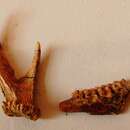fi
nimet breadcrumb-navigoinnissa


Euprox is an extinct genus of deer that lived in Eurasia during the Miocene.
The type species Euprox furcatus was originally under the genus Prox, but that name was already taken. Depéret assigned it to the related genus Dicrocerus in 1887, before it was assigned to its current placement in 1928.[2] Euprox dicranocerus and Euprox minimus were transferred to the genus soon after; they were originally described as Cervus dicranocerus and Dicracerus minimus, respectively.[3]
Euprox was some of the earliest types of deer known to have true antlers.[4] It would have resembled a muntjac in size and appearance, standing at up to 1 m (3.3 ft) in height.
The antlers of Euprox were short, with two small prongs projecting from the main branch. Euprox is notable for being the earliest deer to possess the presence of a real burr, which are indicative of the border between permanent and deciduous segments of deer antlers.[5] It possessed brachyodont teeth and likely fed on leaves.[4] The environment that Euprox inhabited would have been warm and humid, with many tropical forests.[4][6]
L'euproce (gen. Euprox) è un mammifero artiodattilo estinto, appartenente ai cervidi. Visse tra il Miocene medio e il Miocene superiore (circa 16 - 9 milioni di anni fa) e i suoi resti fossili sono stati ritrovati in Europa e in Asia.
Questo animale doveva essere molto simile agli odierni muntiac, e anche le dimensioni dovevano essere paragonabili; è probabile che questo animale superasse di poco il metro di altezza. Le zampe erano lunghe e snelle, mentre il corpo doveva possedere un dorso leggermente arcuato. Euprox possedeva due corte corna sopra le orbite, formate da uno stelo principale e da una corta proiezione anteriore. La principale differenza tra Euprox e gli altri cervi primitivi miocenici era data dalla presenza di una vera e propria rosetta, ancor più evidente che nell'affine Heteroprox, che indicava il limite tra il segmento deciduo e quello permanente dei palchi.
Euprox è stato descritto per la prima volta da Stehlin nel 1928 sulla base di resti provenienti dal Miocene medio della Germania. In seguito sono stati scoperti numerosi altri resti di questo animale in un vasto territorio comprendente Asia (principalmente Cina) ed Europa (Germania, Austria, Polonia, Svizzera, Spagna) in terreni del Miocene medio e superiore.
Ad Euprox sono state attribuite numerose specie: tra queste, da ricordare E. dicranocerus rinvenuta in Spagna, E. furcatus dell'Europa centrale, e le cinesi E. altus (snello e di dimensioni modeste) ed E. robustus (di grosse dimensioni).
Euprox fa parte di una radiazione evolutiva di cervidi del Miocene medio che svilupparono per la prima volta vere e proprie corna caduche, derivati probabilmente da forme primitive come Stehlinoceros e Lagomeryx. Generi affini ad Euprox sono il già citato Heteroprox, il ben noto Dicrocerus e il successivo Amphiprox, più specializzato.
La forma delle ossa delle zampe e in generale del corpo indicano che Euprox era adattato a un clima umido e che probabilmente viveva in folte foreste.
L'euproce (gen. Euprox) è un mammifero artiodattilo estinto, appartenente ai cervidi. Visse tra il Miocene medio e il Miocene superiore (circa 16 - 9 milioni di anni fa) e i suoi resti fossili sono stati ritrovati in Europa e in Asia.